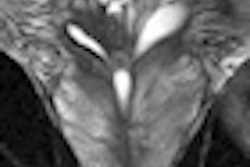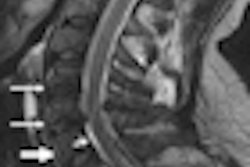The use of preoperative MRI in women with newly diagnosed breast cancer enables surgeons to remove tumors more completely, researchers at Yale University report. As a result, breast cancer patients who undergo pre-op MRI are less likely to require a second excision procedure.
Using MRI preoperatively, the study group saw a particularly dramatic improvement in women with dense breast tissue, who pose a challenge to conventional x-ray mammography. In these women, 7% who had an MRI before surgery underwent re-excision procedures, compared with 26% who did not have an MRI.
In addition, the rate of positive margins -- or tissue around a lesion's borders that is positive for malignancy after surgery -- went from 53% in women with dense breasts who did not have an MRI before surgery to 17% in those who did.
Controversial procedure
Performing MRI exams on patients with newly diagnosed breast cancer before surgery is controversial for surgeons, according to Dr. Liane Philpotts, lead author of the study.
MRI has been shown to define the extent of disease better than mammography or ultrasound, and to detect additional cancers in both the ipsilateral and contralateral breasts in many patients. However, there has been little clinical evidence of MRI's ability to decrease recurrences or improve mortality; in addition, preoperative MRI can complicate and delay treatment, which has led to divergent practices in using the technique at breast care facilities, she said.
"Surgeons have mixed beliefs about the use of MRI preoperatively [with newly diagnosed breast cancer]," Philpotts told AuntMinnie.com. "MRI does have its issues -- it's expensive and the potential for false positives is high. But we do find a lot of other cancers [when we use MRI], and the rates of re-excision and positive margins are reduced."
For the study, Philpotts and colleagues examined the value of preoperative breast MRI in patients for whom conservative therapy was planned by comparing positive margins and re-excision rates between those patients who underwent MRI and those who did not. Philpotts presented the study findings at the RSNA 2011 meeting.
The study included data gleaned from Yale's breast imaging database and from medical records for the period of February 2010 through February 2011; there were 158 cases of breast cancer, with women undergoing needle localization and lumpectomy for newly diagnosed breast cancer. Philpotts' team broke out the data as follows:
- Cancer type, as determined by pathology report
- Invasive ductal (20%)
- Invasive lobular (6%)
- Invasive ductal + ductal carcinoma in situ (DCIS) (42%)
- DCIS alone (28%)
- Patient age (grouped by decade)
- Breast density
- Predominantly fatty (7%)
- Scattered fibroglandular (51%)
- Heterogeneously dense (39%)
- Extremely dense (3%)
- Whether the surgeon used preoperative MRI
- Positive margins
- Additional surgery (including re-excisions and mastectomy)
All MRI scans were performed with a 3-tesla magnet (Magnetom Verio, Siemens Healthcare), a dedicated breast coil (Sentinelle, Hologic), and the contrast agent gadopentetate dimeglumine (Magnevist, Bayer HealthCare Pharmaceuticals). Women who received preoperative MRI were compared with those who did not for the categories listed above; 96 women (61%) had preoperative MRI and 62 (39%) did not.
Preoperative MRI improved the overall rate of positive margins: 13% of the women who had the exam before treatment had positive margins, compared with 17% of the women who did not have preoperative MRI. It also halved the percentage of women overall who had a re-excision procedure performed, with 9% of those who had pre-op MRI undergoing re-excision and 18% of those who did not returning for more surgery, Philpotts reported.
The procedure improved re-excision and positive margin rates in women with heterogeneously dense tissue, in particular, Philpotts said. Of this group, 17% who had an MRI before surgery had positive margins afterward, whereas 53% of women who did not have an MRI had positive margins. In addition, 7% of women with dense breast tissue who had an MRI before surgery underwent re-excision procedures, compared with 26% who did not have an MRI.
The use of MRI before surgery in women newly diagnosed with invasive ductal carcinoma with DCIS reduced positive margin rates as well: 10% of these women had positive margins postprocedure, compared with 31% of women with this particular cancer who did not have pre-op MRI.
Finally, preoperative MRI halved positive margin rates in younger women, from 60% in those between the ages of 39 and 49 who did not have pre-op MRI to 30% in women in this age group who did.
Consistent with these data, the study showed that the surgeon with the lowest utilization of preoperative MRI (i.e., no use) had the highest positive margin rate (64%), whereas the most frequent user (88% use) had a positive margin rate of 15%, according to Philpotts.
"The use of preoperative MRI in selected patients is associated with a statistically significant improved surgical outcome in terms of fewer positive margin rates and re-excisions," she said. "When conservative treatment [such as lumpectomy] is planned, the use of preoperative MRI [among women with heterogeneously dense tissue, those with invasive carcinoma with DCIS, and younger women] should be considered."



















